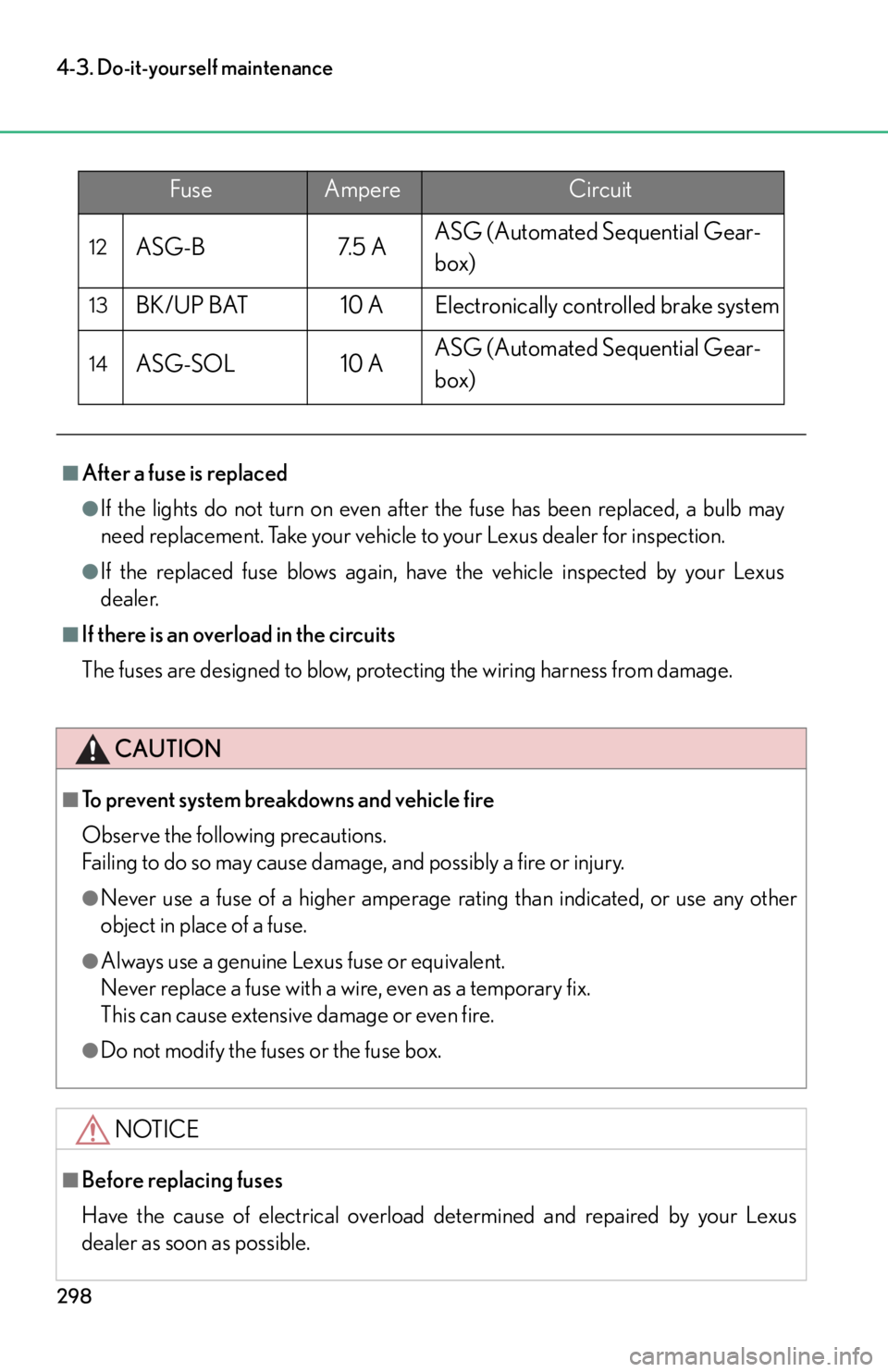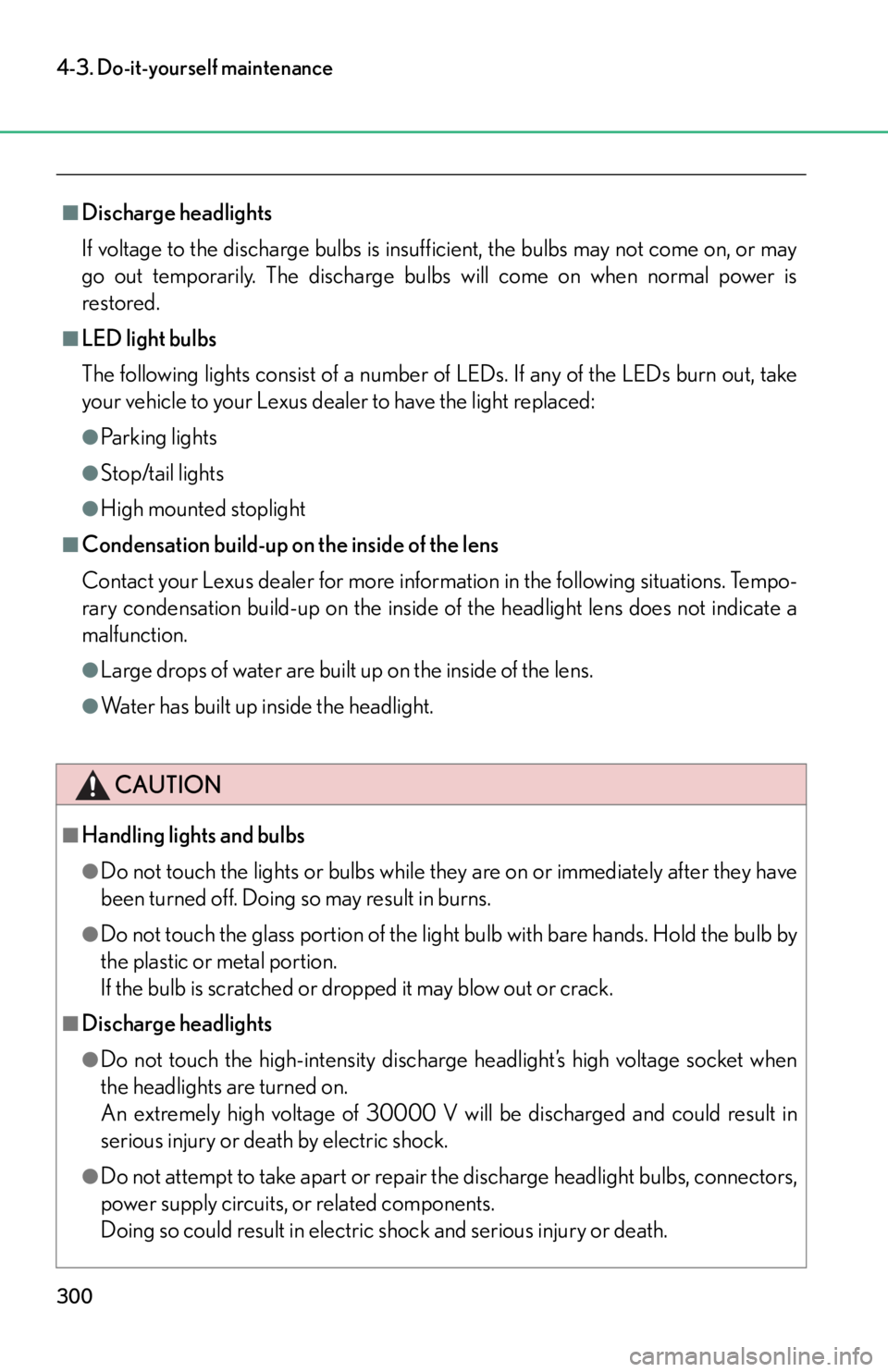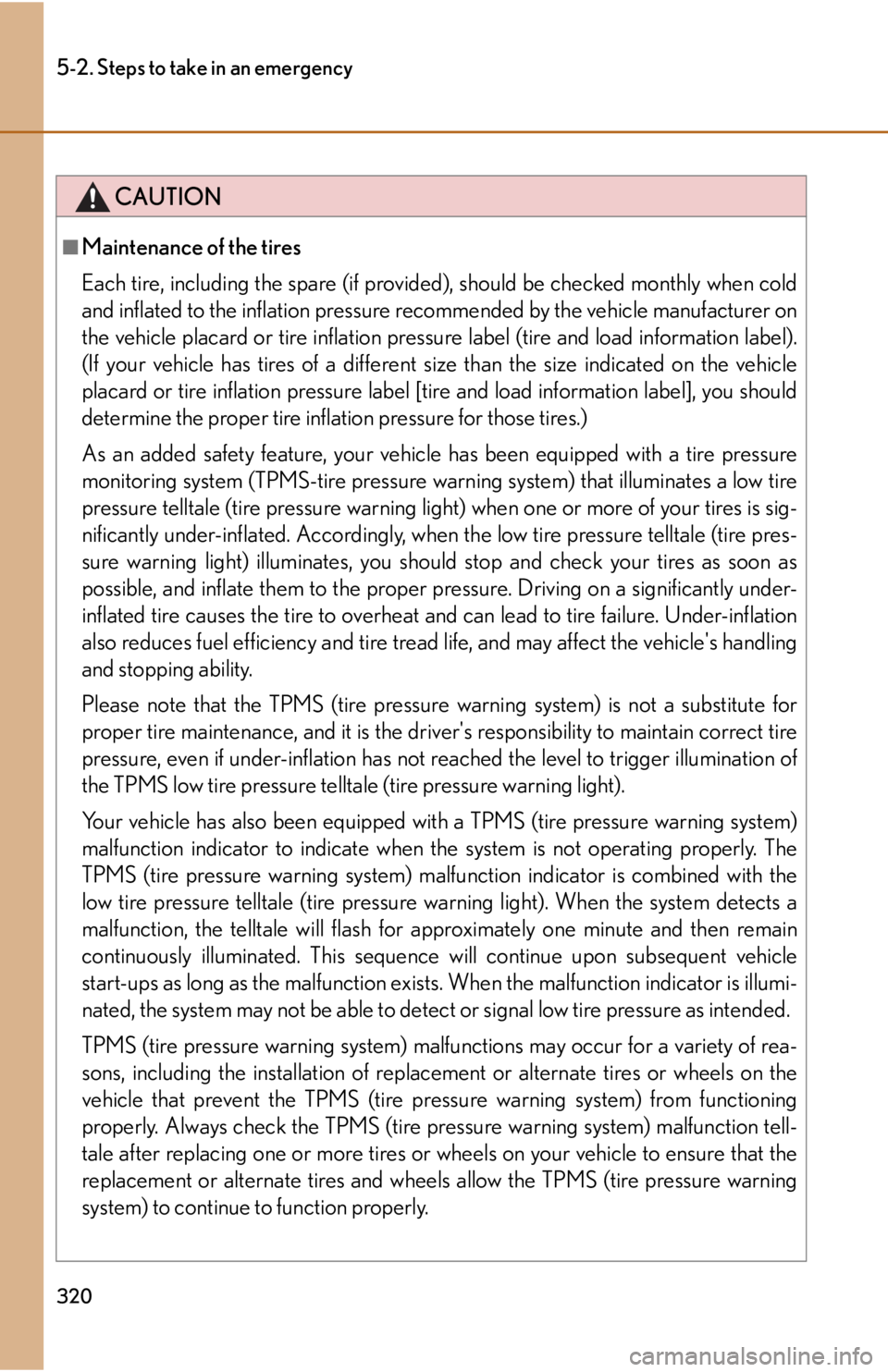Page 300 of 420

298
4-3. Do-it-yourself maintenance
12ASG-B7.5 AASG (Automated Sequential Gear-
box)
13BK/UP BAT 10 A Electronically controlled brake system
14ASG-SOL 10 A ASG (Automated Sequential Gear-
box)
■After a fuse is replaced
●If the lights do not turn on even afte
r the fuse has been replaced, a bulb may
need replacement. Take your vehicle to your Lexus dealer for inspection.
●If the replaced fuse blows again, have the vehicle inspected by your Lexus
dealer.
■If there is an overload in the circuits
The fuses are designed to blow, protecting the wiring harness from damage.
CAUTION
■To prevent system breakdowns and vehicle fire
Observe the following precautions.
Failing to do so may cause damage, and possibly a fire or injury.
●Never use a fuse of a higher amperage rating than indicated, or use any other
object in place of a fuse.
●Always use a genuine Lexus fuse or equivalent.
Never replace a fuse with a wire, even as a temporary fix.
This can cause extensive damage or even fire.
●Do not modify the fuses or the fuse box.
NOTICE
■Before replacing fuses
Have the cause of electrical overload determined and repaired by your Lexus
dealer as soon as possible.
FuseAmpereCircuit
Page 301 of 420
299
4-3. Do-it-yourself maintenance
4
Maintenance and care
Light bulbs
Due to their positioning, the light bulbs may be difficult to replace.
If a light bulb needs replacin g, contact your Lexus dealer.
Front
Rear
■Light bulb types
P. 367
Front side marker lights
Parking lights
Headlight low/high beams and dayt
ime running lights (Canada only)
Front turn signal lights
High mounted stoplight
Rear turn signal lights Back-up lightsLicense plate lights
Stop/tail lights
Rear side marker lights
Page 302 of 420

300
4-3. Do-it-yourself maintenance
■Discharge headlights
If voltage to the discharge bulbs is insufficient, the bulbs may not come on, or may
go out temporarily. The discharge bulbs will come on when normal power is
restored.
■LED light bulbs
The following lights consist of a number of LEDs. If any of the LEDs burn out, take
your vehicle to your Lexus dealer to have the light replaced:
●Parking lights
●Stop/tail lights
●High mounted stoplight
■Condensation build-up on the inside of the lens
Contact your Lexus dealer for more information in the following situations. Tempo-
rary condensation build-up on the inside of the headlight lens does not indicate a
malfunction.
●Large drops of water are built up on the inside of the lens.
●Water has built up inside the headlight.
CAUTION
■Handling lights and bulbs
●Do not touch the lights or bulbs while they are on or immediately after they have
been turned off. Doing so may result in burns.
●Do not touch the glass portion of the light bulb with bare hands. Hold the bulb by
the plastic or metal portion.
If the bulb is scratched or dropped it may blow out or crack.
■Discharge headlights
●Do not touch the high-intensity discharge headlight’s high voltage socket when
the headlights are turned on.
An extremely high voltage of 30000 V wi ll be discharged and could result in
serious injury or death by electric shock.
●Do not attempt to take apart or repair the discharge headlight bulbs, connectors,
power supply circuits, or related components.
Doing so could result in electric shock and serious injury or death.
Page 322 of 420

320
5-2. Steps to take in an emergency
CAUTION
■Maintenance of the tires
Each tire, including the spare (if provided), should be checked monthly when cold
and inflated to the inflation pressure re commended by the vehicle manufacturer on
the vehicle placard or tire inflation pressu re label (tire and load information label).
(If your vehicle has tires of a different size than the size indicated on the vehicle
placard or tire inflation pressure label [tire and load information label], you should
determine the proper tire inflation pressure for those tires.)
As an added safety feature, your vehicl e has been equipped with a tire pressure
monitoring system (TPMS-tire pressure warning system) that illuminates a low tire
pressure telltale (tire pressure warning light) when one or more of your tires is sig-
nificantly under-inflated. Accordingly, when the low tire pressure telltale (tire pres-
sure warning light) illuminates, you should stop and check your tires as soon as
possible, and inflate them to the proper pressure. Driving on a significantly under-
inflated tire causes the tire to overheat and can lead to tire failure. Under-inflation
also reduces fuel efficiency and tire tread life, and may affect the vehicle's handling
and stopping ability.
Please note that the TPMS (tire pressure warning system) is not a substitute for
proper tire maintenance, and it is the driv er's responsibility to maintain correct tire
pressure, even if under-inflation has not reached the level to trigger illumination of
the TPMS low tire pressure telltale (tire pressure warning light).
Your vehicle has also been equipped with a TPMS (tire pressure warning system)
malfunction indicator to indicate when th e system is not operating properly. The
TPMS (tire pressure warning system) malfunction indicator is combined with the
low tire pressure telltale (tire pressure warning light). When the system detects a
malfunction, the telltale will flash for approximately one minute and then remain
continuously illuminated. This sequence will continue upon subsequent vehicle
start-ups as long as the malfunction exists . When the malfunction indicator is illumi-
nated, the system may not be able to detect or signal low tire pressure as intended.
TPMS (tire pressure warning system) malfunctions may occur for a variety of rea-
sons, including the installation of replacem ent or alternate tires or wheels on the
vehicle that prevent the TPMS (tire pres sure warning system) from functioning
properly. Always check the TPMS (tire pressure warning system) malfunction tell-
tale after replacing one or more tires or wheels on your vehicle to ensure that the
replacement or alternate tires and wheels allow the TPMS (tire pressure warning
system) to continue to function properly.
Page 331 of 420
5
When trouble arises
329
5-2. Steps to take in an emergency
Indicates that the washer
fluid level is low.Add washer fluid.
(
P. 2 6 4 )
Indicates that engine oil
level is low. Check the level of engine
oil (
P. 132), and add if
necessary ( P. 2 5 7 ) .
Indicates that the engine
oil needs to be changed. Have the engine oil
changed at your Lexus
dealer. (Also have the oil
maintenance function
reset.)
Indicates that the engine
coolant temperature or
engine oil temperature is
below -13 F (-25 C). Start the engine when the
engine coolant or engine
oil temperature reaches
-1 1
F (-24 C) or higher.
Indicates that the battery
voltage is low. Start the engine.
Indicates that the spark
plugs are dirty or carbon
fouled. Drive the vehicle at 2400
rpm or higher for a total
duration of several min-
utes.
MessageDetailsCorrection procedure
Page 359 of 420
Vehicle specifications6
357
6-1. SpecificationsMaintenance data (fuel, oil level, etc.) .............. 358
Fuel information ..................... 368
Tire information....................... 371
6-2. Customization Customizable features ........ 383
6-3. Initialization Items to initialize .................... 386
Page 360 of 420
358
6-1.Specifications
Maintenance data (fuel, oil level, etc.)
Vehicle identification
■ Vehicle identification number
The vehicle identification number (V IN) is the legal identifier for your
vehicle. This is the primary identi fication number for your Lexus. It is
used in registering the ownership of your vehicle.
This number is stamped on the top
left of the instrument panel and on
the floor behind the right seat.
This number is also on the Certifi-
cation Label.
Page 388 of 420
386
6-3.Initialization
Items to initialize
The following items must be initialized for normal system operation in cases
such as after maintenance is performed on the vehicle.
ItemWhen to initializeReference
Oil maintenance After changing engine oil P. 132
Tire pressure warning
system When changing the tire inflation pres-
sure by changing traveling speed.
P. 2 7 1